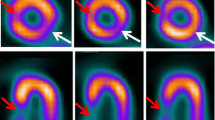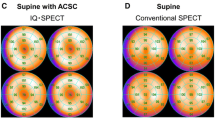Abstract.
The aim of the study was to evaluate quality of myocardial perfusion single-photon emission tomography (SPET) imaging in Finnish hospitals. Nineteen nuclear medicine departments participated in the study. A myocardial phantom simulating clinical stress and rest conditions was filled with routinely used isotope solution (technetium-99m or thallium-201). The cardiac insert included three reversible defects (simulating ischaemia): 30×30×14 mm3 septal (90% recovery at rest), 30×20×14 mm3 posterobasal (full recovery) and 20×20×14 mm3 lateral (full recovery). There were two fixed defects (simulating infarct): 30×20×14 mm3 postero-apical and 10×10×6 mm3 apical. The phantom was imaged and interpreted as a myocardial perfusion patient. Reconstruction, printout and reporting were performed according to the clinical routine of each centre. Three nuclear medicine specialists anonymously evaluated the quality of the image sets. The visual scores of the experts were ranked from 1 to 5. Additionally, points from 0 to 8 were given to research reports according to how well perfusion defects were detected. Quantitative points were calculated by comparing background-subtracted and -normalized counts from 12 regions of interest between stress and rest images. Results for technetium studies (12 departments) were better than those for thallium (7 departments). The average visual scores of the experts were 3.7±0.9 for all image sets, 3.2±0.5 for thallium users and 3.9±0.6 for technetium users (P=0.003). Five laboratories received a low score which, according to the specialists, is barely sufficient for limited clinical use. Average points for the reports were 5.6±2.1, 4.9±1.5 and 6.5±1.7 (P=0.051), and for the quantitation 8.2±1.0, 7.9±0.4 and 8.4±1.1 (P=0.185), respectively. Seven out of 22 interpreters did not detect the lateral 20×20×14 mm3 defect; five of them used thallium. This study demonstrated the heterogeneity of myocardial perfusion SPET in Finland. The participating laboratories used a wide scale of methods and, sometimes, inappropriate imaging protocols. The need for quality assurance in nuclear cardiology, correct use of SPET instrumentation and objective comparison of clinical studies is evident. The method described is suitable for external quality assurance and quality improvement of myocardial SPET imaging, and is recommended for regular use in nuclear medicine.
Similar content being viewed by others
Author information
Authors and Affiliations
Additional information
Reiceived 15 March and in revised form 9 May 1999
Rights and permissions
About this article
Cite this article
Heikkinen, J., Ahonen, A., Kuikka, J. et al. Quality of myocardial perfusion single-photon emission tomography imaging: multicentre evaluation with a cardiac phantom. Eur J Nucl Med 26, 1289–1297 (1999). https://doi.org/10.1007/s002590050585
Issue Date:
DOI: https://doi.org/10.1007/s002590050585




